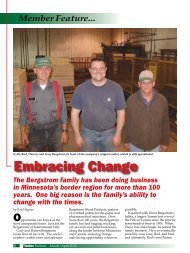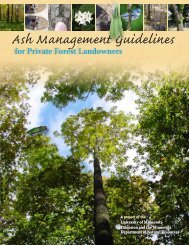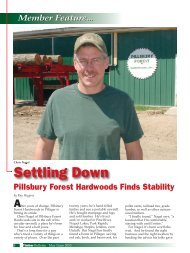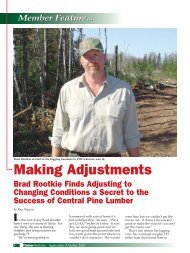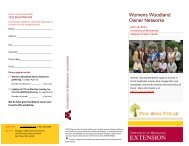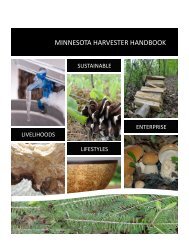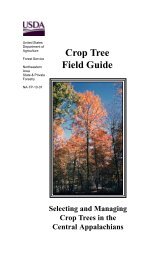Ash Management Guide for Private Forest Landowners
Ash Management Guide for Private Forest Landowners
Ash Management Guide for Private Forest Landowners
Create successful ePaper yourself
Turn your PDF publications into a flip-book with our unique Google optimized e-Paper software.
<strong>Ash</strong> wood has been gathered and shapedinto snowshoes of varied design by manycultures that inhabit the boreal and subboreal<strong>for</strong>est ecosystems. <strong>Ash</strong> wood lendsitself to manipulation and retains its given<strong>for</strong>m once dry. <strong>Ash</strong> is also lightweight,making it ideal <strong>for</strong> snowshoes, toboggans,and vessels. The wood properties of ashhave made them a fiber source <strong>for</strong> a fewMinnesota-made products:Pulp and Paper: Two of Minnesota’spulp and paper mills use small amountsof ash mixed with other species to createpaper pulp. These mills used about 10,000cords of ash in 2007.Engineered Wood: <strong>Ash</strong> is used byone Minnesota mill to manufacture hardboard.Solid Wood Products: Over 100Minnesota sawmills use some ash, butthe overall consumption is low. Total ashuse in 2007 was about 9,000 cords. Thereare several exporters <strong>for</strong> black ash veneer.The volumes are small but these exportsare high value.Minnesota’s ash paneling industryis viable, particularly when it comes toblack ash. Black ash is sawn into panelingand flooring when quantities are available(and that may not be regular or often).<strong>Ash</strong> has always been an offering in thepaneling and flooring industry. Black ashis also used as a craft wood both in nichemarket items and traditional Minnesotacrafteditems such as snowshoes andbaskets. Also, ash is popular <strong>for</strong> firewoodas it is easy to split.While the industry that producespaneling and pallets is big, their use ofash isn’t. There are a couple reasons <strong>for</strong>this. The size and quality of the raw ashmaterial is undependable. Not very muchash makes it to sawlog or veneer size. Thesupply just doesn’t lead to a consistentdemand.Another reason is that harvesting opportunitiesare limited to the season whenthe ground is frozen or dry, because ash ismost often found in lowland areas. Thosein the timber industry tend to focus theiref<strong>for</strong>ts in the winter season on speciesthey are certain they can market.While a number of factors makeharvesting ash undesirable, other characteristicsmake Minnesota ash desirable <strong>for</strong>various industries. <strong>Ash</strong> has a unique, variablegrain pattern that appeals to many.It is not a “light-colored” wood, butit is not a “dark” wood either. It is somewhatvulnerable to fashion swings. Iflight-colored paneling is “in” to make theceilings look higher and the room lookChapter 3<strong>Ash</strong>: A 21stCentury Resource<strong>Ash</strong> trees are common ‘urban trees,’ liningthe streets and boulevards of communitiesthroughout Minnesota. And, as with mosturban tress, ash trees bestow beauty, cutenergy costs, and absorb and filter stormwater – services estimated to be worthover $290 million each year to Minnesotacommunities.Photo: DailyinventionMost often, discussion centers on the largeproportion of ash trees that comprise urbanand suburban landscapes. <strong>Ash</strong> specieswere used to replace elm trees after Dutchelm disease wiped out what was once thepredominant urban landscaping tree. <strong>Ash</strong>trees sometimes comprise one quarter ormore of the trees in municipal areas.17



